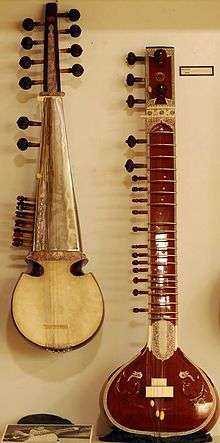Pena (musical instrument)
|
Pena | |
| Classification | |
|---|---|
| Related instruments | |
The Pena, also known as Bana, Bena or Tingtelia, is a mono string instrument falling in the lute category,[1] similar to some of the traditional Indian stringed musical instruments such as Ravanahatha, Ubo or the Kenda, found in various parts of the country.[2] It is the traditional music instrument of the Meitei community[1] of Manipur, India and some parts of Bangladesh and is played either solo or in group, in folk music or as the accompanying musical instrument for Lai Haraoba festivals.[1][3] Pena playing is becoming a dying art as only 145 active Pena players are reported in Manipur.[2][4] The Center for Research on Traditional and Indigenous Art (Laihui), an organization headed by renowned Pena player, Khangembam Mangi Singh, has mandated vision to revive Pena music.[3]
| Music of India | |
|---|---|
 A Lady Playing the Tanpura, ca. 1735 (Rajasthan) | |
| Genres | |
| |
| Media and performance | |
| Music awards | |
| Music festivals | |
| Music media | |
| Nationalistic and patriotic songs | |
| National anthem | Jana Gana Mana |
| Regional music | |
| |
History of the whistle
The Pena, the oldest Meitei musical instrument,[5] was once considered as a part of luxurious living and was played at the royal gatherings.[4][1] However, the instrument slowly got associated with the folk culture of Manipur and Bangladesh where it became a regular presence at the festivals. Manipuri festival of Lai Haraoba fostered the use of the instrument considerably. Later, it also made its presence in the folk theatre.[2]
It is generally believed that the name of the instrument is a derivation of the sanksrit term, Vina, evolved from the Bengali version of Bina. The other names, Bena or Bana are also considered to be evolved from the parent term of Vina.[2] The musical instrument, Pinaki vina, mentioned in ancient Sanskrit texts is similar to this instrument.[6] The Nagas call the instrument, Tingtelia.[2]
Construction
The instrument consist of two parts, the main body, penamasa or dhorr which is similar to that of a violin and the bow, pena cheijing or chorr, which is more resembling an archery bow than a violin bow.[7] The main body is made out of bamboo, 10 to 11 inches long and 1 to 1.25 inches girth, which is fixed to a coconut shell cut in half, through two holes bore through the shell.[1] Two additional holes are also drilled on the coconut shell for acoustic purposes, one of which is covered by dried animal skin such as iguana skin and the other, left open. The tension of the string is controlled by a bamboo peg, called kaan and is fitted inside a hole drilled on the bamboo rod. A scroll, mogra, is also tied to the instrument tail.[2]
The bow is wooden and bears a curved flourish at one end which is made of metal. In some parts, the bow also features tiny metal bells. The string is traditionally made of horse hair but, sometimes, metal strings and strings made out of wood fiber are also used.[2]
Well-known performers
- Khangembam Mangi Singh
- Guru N.G. Ibopishak
- Leimapokpam Yaima
- Mayanglambam Mangangsana
See also
References
- 1 2 3 4 5 "Yahoo News". Yahoo News. 2014. Retrieved November 18, 2014.
- 1 2 3 4 5 6 7 "Chandrakantha". Chandrakantha. 2014. Retrieved November 18, 2014.
- 1 2 "Tehelka". Tehelka. 2014. Retrieved November 18, 2014.
- 1 2 "Huyeien Lan Pao". Huyeien Lan Pao. 2014. Retrieved November 18, 2014.
- ↑ "Ani News". Ani News. 2014. Retrieved November 18, 2014.
- ↑ "Santoor". Santoor. 2014. Retrieved November 18, 2014.
- ↑ "Manipur Online". Manipur Online. December 23, 2010. Retrieved November 18, 2014.
External links
- "Traditional indigenous musical instrument Pena being revived in Manipur". Video. YouTube. 3 June 2014. Retrieved November 18, 2014.
- "Pena - a project on Manipuri musical instrument". Video. YouTube. 14 April 2012. Retrieved November 18, 2014.

